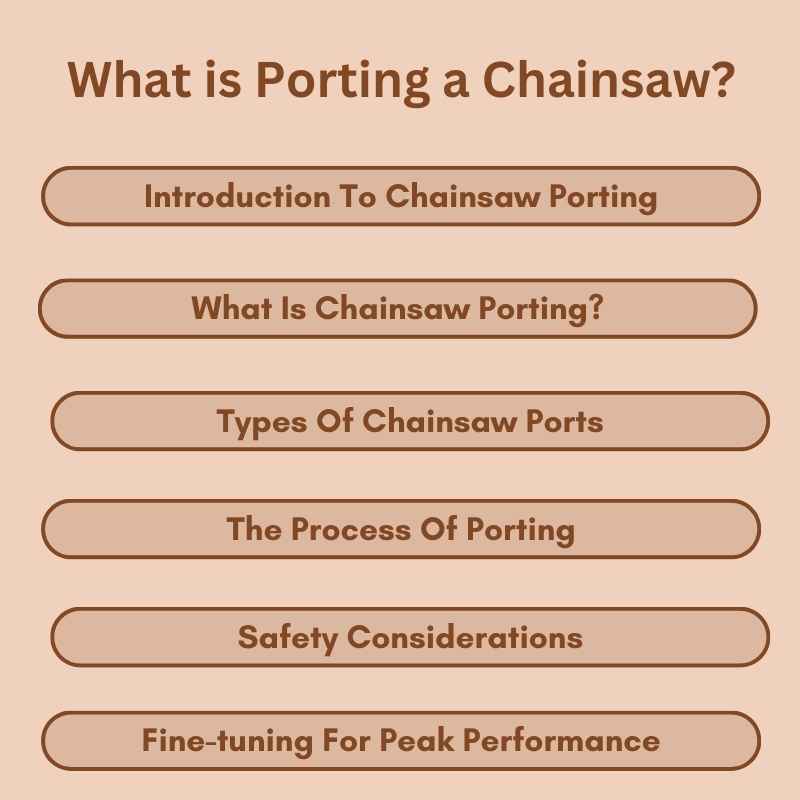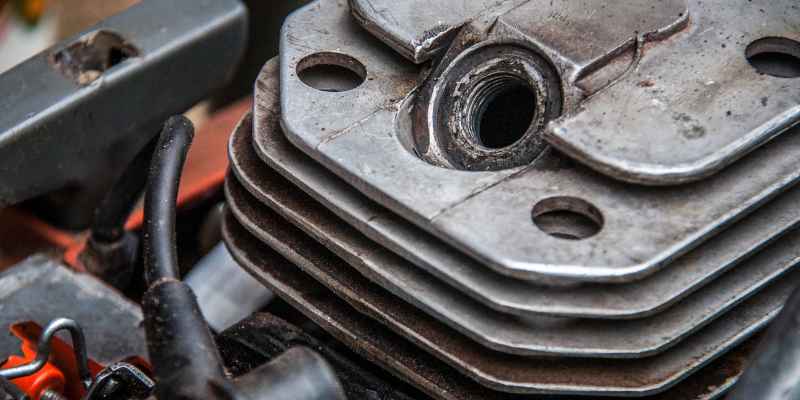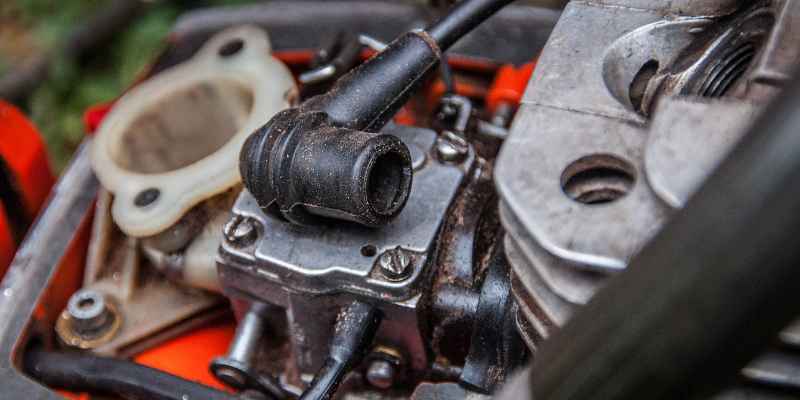Porting a chainsaw is the process of modifying the engine to increase its power output. A chainsaw is a versatile tool that is widely used for cutting wood, pruning trees, and other outdoor tasks.
However, the power of a chainsaw’s engine may not be sufficient for some heavy-duty tasks. This is where porting comes in. Porting involves modifying the engine to increase its power output by improving the flow of air and fuel into the combustion chamber.
The process involves grinding and polishing the intake and exhaust ports to create smooth, straight channels that allow air and fuel to flow more efficiently. This results in increased power and performance from the chainsaw. Porting can be a complex process that requires specialized knowledge and tools, but it can be a worthwhile investment for those who require more power from their chainsaw.
Introduction To Chainsaw Porting
Porting a chainsaw involves modifying its engine to enhance performance. By optimizing the airflow, fuel mixture, and exhaust flow, porting can increase power and efficiency, resulting in improved cutting performance.
Chainsaw porting is a technique used to modify a chainsaw’s engine for optimal performance. Porting involves modifying the intake and exhaust ports of the engine to improve airflow, which in turn enhances the engine’s horsepower and torque. This process can be performed by experienced chainsaw technicians or enthusiasts with the necessary tools and knowledge. In this section, we will discuss the basics of chainsaw modification and the potential benefits of porting your chainsaw.
The Basics Of Chainsaw Modification
Chainsaw porting is a modification process that requires precision and attention to detail. The process involves enlarging the intake and exhaust ports of the engine to improve airflow and increase horsepower and torque. This can be achieved by using specialized tools such as a rotary burr, sanding rolls, and a die grinder. However, it is important to note that porting should only be performed by experienced technicians or enthusiasts with the necessary knowledge and skills.
Potential Benefits For Your Chainsaw
Porting your chainsaw can have several potential benefits. The most significant advantage is increased engine performance, which results in faster cutting and increased productivity. Porting can also enhance fuel efficiency, allowing you to work for longer periods without needing to refuel. Additionally, porting can reduce the engine’s operating temperature, which can help extend the lifespan of the chainsaw. However, it is important to note that improper porting can lead to engine damage and reduced performance. Therefore, it is crucial to consult with an experienced technician or do thorough research before attempting to modify your chainsaw.
In conclusion, chainsaw porting is a modification technique that can significantly improve your chainsaw’s performance. However, it should only be performed by experienced technicians or enthusiasts with the necessary knowledge and tools. The potential benefits of porting include increased engine performance, fuel efficiency, and reduced operating temperature. If you are considering porting your chainsaw, be sure to consult with an experienced technician or do thorough research to ensure proper modification and optimal results.

What Is Chainsaw Porting?
Chainsaw porting is the process of modifying the intake and exhaust ports of a chainsaw to enhance its performance. By reshaping and enlarging these ports, airflow is improved, resulting in increased power and efficiency. This technique is commonly employed by professionals and enthusiasts to optimize a chainsaw’s cutting ability.
Defining Porting In The Context Of Chainsaws
Chainsaw porting is the process of modifying the intake and exhaust ports in the cylinder of a chainsaw to improve its performance.
How Porting Affects Chainsaw Performance
– Increases airflow to boost power output.
– Enhances fuel mixture combustion efficiency.
– Improves overall engine performance and acceleration.
Chainsaw porting optimizes the engine’s airflow for better combustion, resulting in increased power and efficiency.
Types Of Chainsaw Ports

When it comes to understanding the inner workings of a chainsaw, it’s essential to delve into the world of porting. Porting a chainsaw involves modifying the intake, exhaust, and transfer ports in the engine to enhance its performance. These modifications can significantly impact the power output and efficiency of the chainsaw. In this article, we will explore the different types of chainsaw ports and their roles in optimizing the performance of these powerful tools.
Intake Ports
The intake ports are responsible for allowing the fuel-air mixture to enter the combustion chamber. By carefully shaping and positioning these ports, chainsaw enthusiasts can improve the flow of the mixture and optimize the engine’s efficiency. Properly designed intake ports can enhance the chainsaw’s power output and overall performance.
Exhaust Ports
Exhaust ports play a crucial role in expelling the burnt fuel-air mixture from the combustion chamber. Optimizing the design and size of the exhaust ports can improve the scavenging process, leading to better combustion efficiency and increased power output. Additionally, well-ported exhaust ports can contribute to reducing emissions and minimizing environmental impact.
Transfer Ports
Transfer ports facilitate the movement of the fuel-air mixture from the crankcase to the combustion chamber. By strategically modifying the transfer ports, chainsaw enthusiasts can enhance the scavenging process, improve fuel combustion, and increase power delivery. Properly ported transfer ports can contribute to a more efficient and powerful chainsaw operation.
The Process Of Porting
Porting a chainsaw involves modifying the intake and exhaust ports in the engine cylinder to enhance performance. This process optimizes airflow and fuel mixture, resulting in increased power and torque. Professional porting can improve the chainsaw’s cutting efficiency and overall operation.
Porting a chainsaw is a process that involves modifying the intake and exhaust ports to improve the engine’s performance. By reshaping these ports, you can increase the airflow and fuel mixture, resulting in better combustion and more power. If you’re interested in porting your chainsaw, here’s a step-by-step guide to help you get started.
Tools Required For Chainsaw Porting
To successfully port your chainsaw, you’ll need a few essential tools. Here’s a list of what you’ll need:
- Protective gear: Safety glasses, gloves, and ear protection
- Chainsaw wrench: To disassemble and reassemble the chainsaw
- Porting kit: Includes various grinding and shaping tools
- Dremel tool or die grinder: To precisely shape the ports
- Files and sandpaper: For smoothing and finishing the ports
- Engine degreaser and cleaning brushes: To remove debris and carbon buildup
- Measuring tools: Calipers or micrometers to measure port dimensions
Step-by-step Guide To Porting
Now that you have the necessary tools, let’s dive into the step-by-step process of porting your chainsaw:
- Preparation:
- Ensure the chainsaw is turned off and the spark plug is disconnected
- Wear the necessary protective gear to prevent any injuries
- Clean the chainsaw thoroughly to remove any dirt or debris
- Disassembly:
- Use the chainsaw wrench to remove the bar and chain
- Take off the cover and remove the air filter
- Disconnect the throttle linkage and remove the carburetor
- Detach the cylinder and piston assembly from the engine
- Port shaping:
- Identify the intake and exhaust ports on the cylinder
- Using the Dremel tool or die grinder, carefully shape the ports
- Remove any rough edges or obstructions that may restrict airflow
- Ensure the port dimensions are within specifications for optimal performance
- Finishing:
- Smooth out the ports using files and sandpaper
- Clean the cylinder and piston assembly to remove any metal shavings
- Reassemble the chainsaw, following the reverse order of disassembly
- Double-check all connections and ensure everything is tightly secured
- Testing and tuning:
- Reinstall the spark plug and connect the ignition system
- Start the chainsaw and carefully monitor its performance
- Adjust the carburetor settings to achieve the desired power and fuel efficiency
- Make any necessary fine-tuning adjustments to optimize the chainsaw’s performance
Porting your chainsaw can be a rewarding project for those looking to enhance their chainsaw’s performance. By following this step-by-step guide and using the right tools, you can effectively reshape the ports and unlock the full potential of your chainsaw’s engine. Remember to prioritize safety and take your time to ensure a precise and well-executed porting process. Happy porting!
Safety Considerations
When it comes to porting a chainsaw, prioritizing safety is absolutely crucial. Without the proper precautions, this task can pose significant risks to both the user and those in the surrounding area. By understanding the importance of safety gear and being aware of the potential risks involved, you can ensure a safe and successful porting process.
Importance Of Safety Gear
Wearing the appropriate safety gear is paramount when undertaking any chainsaw-related task, including porting. The following safety gear should be worn to minimize the risk of injury:
- Protective Eyewear: Safety glasses or goggles shield your eyes from flying debris and wood chips.
- Ear Protection: Wearing earplugs or earmuffs helps safeguard your hearing from the loud noise produced by the chainsaw.
- Gloves: Sturdy, non-slip gloves provide a secure grip and protect your hands from cuts and abrasions.
- Protective Clothing: Opt for long-sleeved shirts, long pants, and sturdy boots to shield your body from potential injuries.
- Chainsaw Chaps: These specialized chaps are designed to reduce the severity of injuries in case of contact with the chainsaw chain.
Risks Involved In Porting
Porting a chainsaw involves modifying the engine’s airflow and fuel systems to enhance performance. However, this process carries certain risks that should be carefully considered:
- Increased Engine Power: Porting can lead to a significant increase in engine power, which may result in a more powerful and potentially harder-to-control chainsaw.
- Increased Heat: Modifying the engine’s airflow can cause higher operating temperatures, increasing the risk of overheating and potential damage to the chainsaw.
- Voiding Warranty: Porting a chainsaw typically voids the manufacturer’s warranty. It’s important to weigh the benefits of increased performance against the loss of warranty coverage.
- Improper Modifications: Inadequate knowledge or incorrect modifications during the porting process can lead to engine damage, decreased performance, or even dangerous malfunctions.
By acknowledging these risks and taking the necessary precautions, you can ensure a safer porting experience. Remember, safety should always be the top priority when working with chainsaws or any other power tools.
Fine-tuning For Peak Performance
When it comes to achieving optimal performance from your chainsaw, fine-tuning is key. Porting a chainsaw involves modifying the intake and exhaust ports to enhance its power and efficiency. This process requires precision and expertise to ensure peak performance. Let’s delve into the details of fine-tuning a ported chainsaw for optimal results.
Adjusting The Carburetor Post-porting
After porting your chainsaw, adjusting the carburetor is essential to optimize the air-fuel mixture for increased power and efficiency. Fine-tuning the carburetor ensures that the engine runs smoothly and delivers maximum performance. This step is crucial in achieving the desired power output and preventing engine damage.
Testing And Refining Port Modifications
Testing and refining the port modifications is a meticulous process that involves evaluating the impact of the modifications on the chainsaw’s performance. By conducting thorough tests, you can identify areas for further improvement and ensure that the port modifications align with the desired performance goals. Refining the port modifications based on the test results is crucial for achieving peak performance.
Pros And Cons Of Porting
Porting a chainsaw involves modifying the engine to boost performance. Pros include increased power and speed. Cons may include voiding warranties and potential damage if not done correctly. It’s crucial to weigh the benefits against the risks before deciding to port your chainsaw.
Enhanced Power And Efficiency
Porting a chainsaw can lead to increased power and efficiency.
It allows for better fuel combustion and more air intake.
This results in enhanced cutting performance and faster operation.
Potential Drawbacks And Longevity Concerns
Porting can reduce the chainsaw’s longevity and durability.
It may lead to overheating and excessive wear.
Warranty void and maintenance costs could increase.
Alternative Performance Enhancements

Porting a chainsaw involves modifying the engine to improve its performance. This includes reshaping the intake and exhaust ports, as well as adjusting the timing. These enhancements can result in increased power and speed, making the chainsaw more efficient for cutting tasks.
Upgrades Without Porting
Comparing Porting To Other Modifications
In the world of chainsaw performance enhancements, there are alternative ways to boost power and efficiency without necessarily resorting to porting. Upgrades without porting focus on optimizing other components of the chainsaw to achieve similar results. When considering comparing porting to other modifications, it’s essential to evaluate the pros and cons of each method. Different modifications may offer varying benefits in terms of performance, cost, and ease of implementation.
Finding A Professional Chainsaw Porter
When seeking a professional chainsaw porter, it’s crucial to find a skilled individual who can enhance your chainsaw’s performance. Let’s explore the key aspects to consider when looking for a proficient porter.
Qualities Of A Skilled Porter
- Technical expertise in chainsaw modifications.
- Experience in porting various chainsaw models.
- Attention to detail in precision work.
- Knowledge of optimal porting techniques.
Where To Find Porting Services
- Specialized workshops with chainsaw porting services.
- Online forums for recommendations on skilled porters.
- Professional chainsaw repair shops offering porting services.
DIY Porting Vs. Professional Services
Porting a chainsaw involves modifying the engine to enhance its performance. While some individuals prefer the DIY approach, professional services offer expertise and precision. Whether you tackle it yourself or opt for professional assistance, porting can significantly improve your chainsaw’s power and efficiency.
Weighing The Cost And Benefits
Porting a chainsaw can enhance performance and power.
- DIY: Affordable but risky if lacking experience.
- Professional: Costlier but ensures precision and quality.
Consider budget and expertise before deciding.
When To Seek Professional Help
Complex porting tasks are best left to professionals.
- If unsure about the process, consult experts.
- Professional services guarantee optimal results.
Choose based on the intricacy of the porting job.
Maintenance After Porting
After porting a chainsaw, proper maintenance is crucial to ensure its optimal performance and longevity. Routine upkeep and long-term care are essential for keeping a ported chainsaw in top condition. Let’s explore the necessary maintenance steps to preserve the enhanced capabilities of a ported chainsaw.
Routine Upkeep For Ported Chainsaws
- Regularly clean the air filter to prevent debris from entering the engine.
- Check and tighten the chain regularly to maintain optimal tension.
- Inspect the spark plug and replace it if necessary to ensure efficient ignition.
- Keep the chain lubricated to minimize friction and prevent premature wear.
Long-term Care Tips
- Monitor the cylinder for signs of wear and tear, and address any issues promptly.
- Perform periodic compression tests to assess the engine’s overall health.
- Use high-quality fuel and oil to reduce carbon buildup and maintain engine cleanliness.
- Consider professional servicing at regular intervals to address any potential porting-related issues.
Frequently Asked Questions
What Is Porting A Chainsaw?
Porting a chainsaw refers to the process of modifying the engine’s intake and exhaust ports to enhance performance. This involves reshaping the ports to optimize airflow and increase power output. Porting can lead to improved acceleration, higher RPMs, and overall better cutting performance.
How Does Porting A Chainsaw Improve Performance?
Porting a chainsaw improves performance by increasing the flow of air and fuel mixture into the engine and enhancing the expulsion of exhaust gases. This results in improved combustion efficiency, leading to more power output. The modified ports allow for better scavenging and reduced resistance, resulting in enhanced acceleration and overall cutting performance.
Is Porting A Chainsaw Safe?
Porting a chainsaw should only be performed by experienced professionals who understand the intricacies of engine modifications. If done incorrectly, it can cause irreversible damage to the engine and compromise safety. It is essential to consult experts in the field who can ensure that the modifications are done accurately and safely.
Can Porting A Chainsaw Void The Warranty?
Yes, porting a chainsaw can void the warranty provided by the manufacturer. Modifying the engine through porting or any other alterations not recommended by the manufacturer can nullify any existing warranty. It is crucial to consider this before opting for porting and consult the manufacturer’s guidelines to avoid warranty-related issues.
Conclusion
To sum up, porting a chainsaw can significantly enhance its performance and power. It involves modifying the engine to increase airflow and fuel intake. This process should be undertaken by a professional to ensure safety and optimal results. When done correctly, porting can transform a standard chainsaw into a high-performance tool for demanding cutting tasks.

